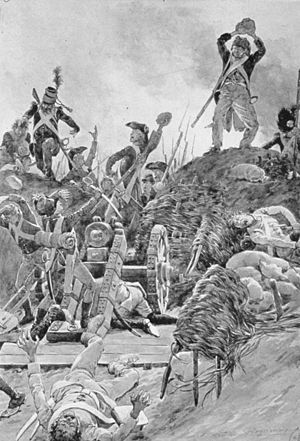
Back حملة الراين 1796 Arabic Rheinfeldzug von 1796 German 1796. aasta Reini sõjakäik Estonian 1796年莱茵战役 Chinese
| Rhine campaign of 1796 | |||||||
|---|---|---|---|---|---|---|---|
| Part of the War of the First Coalition | |||||||
 Taking one of the redoubts of Kehl by throwing rocks, 24 June 1796, Frédéric Regamey | |||||||
| |||||||
| Belligerents | |||||||
|
|
| ||||||
| Commanders and leaders | |||||||
|
|
| ||||||
| Units involved | |||||||
|
Army of the Lower Rhine Army of the Upper Rhine |
Army of Sambre and Meuse Army of the Rhine and Moselle | ||||||
In the Rhine campaign of 1796 (June 1796 to February 1797), two First Coalition armies under the overall command of Archduke Charles outmaneuvered and defeated two French Republican armies. This was the last campaign of the War of the First Coalition, part of the French Revolutionary Wars.
The French military strategy against Austria called for a three-pronged invasion to surround Vienna, ideally capturing the city and forcing the Holy Roman Emperor to surrender and accept French Revolutionary territorial integrity. The French assembled the Army of Sambre and Meuse commanded by Jean-Baptiste Jourdan against the Austrian Army of the Lower Rhine in the north. The Army of the Rhine and Moselle, led by Jean Victor Marie Moreau, opposed the Austrian Army of the Upper Rhine in the south. A third army, the Army of Italy, commanded by Napoleon Bonaparte, approached Vienna through northern Italy.
The early success of the Army of Italy initially forced the Coalition commander, Archduke Charles, to transfer 25,000 men commanded by Dagobert Sigmund von Wurmser to northern Italy. This weakened the Coalition force along the 340-kilometer (211-mile) front stretching along the Rhine from Basel to the North Sea. Later, a feint by Jourdan's Army of Sambre and Meuse convinced Charles to shift troops to the north, allowing Moreau to cross the Rhine at the Battle of Kehl on 24 June and defeated the Archduke's Imperial contingents. Both French armies penetrated deep into eastern and southern Germany by late July, forcing the southern states of the Holy Roman Empire into punitive armistices. By August, the French armies had extended their fronts too thinly and rivalry among the French generals complicated cooperation between the two armies. Because the two French armies operated independently, Charles was able to leave Maximilian Anton Karl, Count Baillet de Latour with a weaker army in front of Moreau on the southernmost flank and move many reinforcements to the army of Wilhelm von Wartensleben in the north.
At the Battle of Amberg on 24 August and the Battle of Würzburg on 3 September, Charles defeated Jourdan's northern army and compelled the French army to retreat, eventually to the west bank of the Rhine. With Jourdan neutralized and retreating into France, Charles left Franz von Werneck to watch the Army of Sambre and Meuse, making sure it did not try to recover a foothold on the east bank of the Rhine. After securing the Rhine crossings at Bruchsal and Kehl, Charles forced Moreau to retreat south. During the winter the Austrians reduced the French bridgeheads in the sieges of Kehl and the Hüningen, and forced Moreau's army back to France. Despite Charles' success in the Rhineland, Austria lost the war in Italy, against Napoleon Bonaparte, which resulted in the Peace of Campo Formio.
© MMXXIII Rich X Search. We shall prevail. All rights reserved. Rich X Search